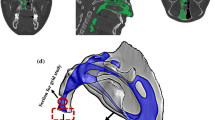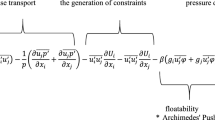Abstract
People often experience unpleasant situations related to water supply or wastewater network dysfunction. For example, a wrong procedure of filling a discharge pipe or a sudden thunderstorm may modify the flow structure. Over or under pressures will induce overflows, cavitation phenomenon, or pipes bursting. In this background and through the present work, we initially attempt to simulate the transient pressure profile along a partially filled pipe. Flow is modeled by a turbulent hybrid model, including near and far from the wall domain. However, for calculus, the volume of fluid VOF method is used first, then coupled to level set one LSCVOF. Numerical results reveal that the pipe is fully pressurized when the VOF method is used and when the LSCVOF is applied. Furthermore, simulation results present a good correlation compared to the stationary state, which is more important as the level set is associated. Therefore, the most recommended method to simulate transient flow through the partially filled conduit is the LSVOF one.
Access provided by Autonomous University of Puebla. Download conference paper PDF
Similar content being viewed by others
Keywords
1 Introduction
To simulate the transition from free surface flow, investigators propose several models (Kerger et al., 2009; Konozsy, 2019). However, many factors influencing this phenomenon make mathematical modeling difficult (Mokrane, 2021). In the present work, we use a turbulent hybrid model that considers both near and far from the pipe wall zone. This consists of a combination between the K-omega and the K-epsilon models (Kerger et al., 2011).
2 Methods
A transient flow, through a partially filled pipe initially, may be governed by the Navier Stokes equations. We choose a turbulent hybrid model, said sstk-omega designing shear stress transport k-omega. This model comprises the K-omega one available in sub-layers near the pipe wall and the K-epsilon available away from the pipe walls. On the other hand, we first use the volume of fluid (VOF) as a computational method. Then Level set (LS) method is associated with the VOF one as a coupled level set—the volume of fluid method (CLSVOF).
Hence, the curvature problem generated when the interface is tracked using the VOF method may be eliminated thanks to the LS. Furthermore, numerical results are compared in each case to experimental data. Finally, the most appropriate procedure will be recommended.
3 Results
3.1 Results Issued from the VOF Method
In this case, the turbulent hybrid model sst k-omega is solved thanks to the volume of the fluid method. Numerical results and experimental ones are shown in Fig. 1, where Pvof indicates static pressure values obtained when the VOF technique is used, and Pexp designs the experimental result.
3.2 Results Issued from CLSVOF Method
In the second step, the coupled method is used to compute the turbulent hybrid model solutions, and results are presented in Fig. 2, where Pvoflsm indicates static pressure values obtained thanks to the CLSVOF method.
3.3 Results of Correlation Between VOF and CLSVOF Results
Here we present the correlation between the volume of fluid method and the coupled one to the Level set method. This is shown in Fig. 3.
4 Discussion
Numerical results and solutions of the turbulent hybrid model ‘sst k-omega’ are plotted on experimental results corresponding to a stationary state. This concerns static pressure values presented in Figs. 1 and 2.
Computed results ‘Pvof’ are issued from the volume of the fluid numerical method. Data presented in Fig. 1 illustrate a high negative correlation with experimental results. This reveals a linear monotone relationship between numerical and experimental results, which develop differently. This will be augmented by a numerical solution obtained through a lap of time and exceeds 500 Pascals. Hence, this means that the pipe is entirely pressurized.
When the CLSVOF method is used, numerical results of the static pressure plot, depending on those of the stationary state, show a high negative correlation value, according to Fig. 2. This reflects a linear monotone relationship between numerical and experimental results, which evolve in two different directions. Also, all numerical solution values express a completely pressurized flow.
To examine the convergence of the VOF and the CLSVOF techniques, results are plotted in Fig. 3, and a high positive correlation is detected. However, the CLSVOF method has displayed the highest correlation coefficient value with the experimental results and is the most recommended.
5 Conclusions
To simulate transient turbulent flow through a partially filled pipe, the hybrid model sst k-omega permits considering all flow zones near and away from the pipe wall. Hence, choosing an adequate procedure to solve this mathematical model is necessary. Therefore, the present work applied different numerical methods, the volume of fluid one, firstly, then coupled with the level set one.
Compared to experimental results, numerical solutions have revealed that the coupled method designed by CLSVOF is the most recommended. However, a high convergence is found between the two approved techniques through a high correlation between numerical solutions issued from the cited methods.
References
Kerger, F., Archambeau, P., Erpicum, S., Dewals, B., & Pirotton, M. (2009). Simulation numérique des écoulements mixtes hautement transitoires dans les conduites d’évacuation des eaux. Houille Blanche, 5, 01–08.
Kerger, F., Archambeau, P., Erpicum, S., Dewals, B., & Pirotton, M. (2011). An exact Riemann solver and a Godunov scheme for simulating highly transient mixed flows. Journal of Computational and Applied Mathematics, 235, 2030–2040.
Konozsy, L. (2019). A new hypothesis on the anisotropic Reynolds stress tensor for turbulent flows (1st ed.). Springer.
Mokrane, W. (2021). Effect of solid deposition on the risk of pressure surges in closed pipes. Euro-Mediterranean Journal for Environmental Integration, 6(28), 01–07.
Author information
Authors and Affiliations
Corresponding author
Editor information
Editors and Affiliations
Rights and permissions
Copyright information
© 2023 The Author(s), under exclusive license to Springer Nature Switzerland AG
About this paper
Cite this paper
Mokrane, W. (2023). A Turbulent Hybrid Model to Simulate a Partially Pressurized Flow. In: Çiner, A., et al. Recent Research on Environmental Earth Sciences, Geomorphology, Soil Science, Paleoclimate, and Karst. MedGU 2021. Advances in Science, Technology & Innovation. Springer, Cham. https://doi.org/10.1007/978-3-031-42917-0_27
Download citation
DOI: https://doi.org/10.1007/978-3-031-42917-0_27
Published:
Publisher Name: Springer, Cham
Print ISBN: 978-3-031-42916-3
Online ISBN: 978-3-031-42917-0
eBook Packages: Earth and Environmental ScienceEarth and Environmental Science (R0)







